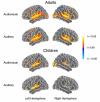Neural development of networks for audiovisual speech comprehension
- PMID: 19781755
- PMCID: PMC2891225
- DOI: 10.1016/j.bandl.2009.08.005
Neural development of networks for audiovisual speech comprehension
Abstract
Everyday conversation is both an auditory and a visual phenomenon. While visual speech information enhances comprehension for the listener, evidence suggests that the ability to benefit from this information improves with development. A number of brain regions have been implicated in audiovisual speech comprehension, but the extent to which the neurobiological substrate in the child compares to the adult is unknown. In particular, developmental differences in the network for audiovisual speech comprehension could manifest through the incorporation of additional brain regions, or through different patterns of effective connectivity. In the present study we used functional magnetic resonance imaging and structural equation modeling (SEM) to characterize the developmental changes in network interactions for audiovisual speech comprehension. The brain response was recorded while children 8- to 11-years-old and adults passively listened to stories under audiovisual (AV) and auditory-only (A) conditions. Results showed that in children and adults, AV comprehension activated the same fronto-temporo-parietal network of regions known for their contribution to speech production and perception. However, the SEM network analysis revealed age-related differences in the functional interactions among these regions. In particular, the influence of the posterior inferior frontal gyrus/ventral premotor cortex on supramarginal gyrus differed across age groups during AV, but not A speech. This functional pathway might be important for relating motor and sensory information used by the listener to identify speech sounds. Further, its development might reflect changes in the mechanisms that relate visual speech information to articulatory speech representations through experience producing and perceiving speech.
2009 Elsevier Inc. All rights reserved.
Figures



Similar articles
-
Physical and perceptual factors shape the neural mechanisms that integrate audiovisual signals in speech comprehension.J Neurosci. 2011 Aug 3;31(31):11338-50. doi: 10.1523/JNEUROSCI.6510-10.2011. J Neurosci. 2011. PMID: 21813693 Free PMC article.
-
Increased Connectivity among Sensory and Motor Regions during Visual and Audiovisual Speech Perception.J Neurosci. 2022 Jan 19;42(3):435-442. doi: 10.1523/JNEUROSCI.0114-21.2021. Epub 2021 Nov 23. J Neurosci. 2022. PMID: 34815317 Free PMC article.
-
Neural Mechanisms Underlying Cross-Modal Phonetic Encoding.J Neurosci. 2018 Feb 14;38(7):1835-1849. doi: 10.1523/JNEUROSCI.1566-17.2017. Epub 2017 Dec 20. J Neurosci. 2018. PMID: 29263241 Free PMC article.
-
Speech comprehension aided by multiple modalities: behavioural and neural interactions.Neuropsychologia. 2012 Apr;50(5):762-76. doi: 10.1016/j.neuropsychologia.2012.01.010. Epub 2012 Jan 17. Neuropsychologia. 2012. PMID: 22266262 Free PMC article.
-
Neural basis of speech perception.Handb Clin Neurol. 2015;129:149-60. doi: 10.1016/B978-0-444-62630-1.00008-1. Handb Clin Neurol. 2015. PMID: 25726267 Review.
Cited by
-
Atypical audiovisual word processing in school-age children with a history of specific language impairment: an event-related potential study.J Neurodev Disord. 2016 Sep 5;8(1):33. doi: 10.1186/s11689-016-9168-3. eCollection 2016. J Neurodev Disord. 2016. PMID: 27597881 Free PMC article.
-
Neural correlates of phonetic convergence and speech imitation.Front Psychol. 2013 Sep 11;4:600. doi: 10.3389/fpsyg.2013.00600. eCollection 2013. Front Psychol. 2013. PMID: 24062704 Free PMC article.
-
Brain repair after stroke--a novel neurological model.Nat Rev Neurol. 2013 Dec;9(12):698-707. doi: 10.1038/nrneurol.2013.222. Epub 2013 Nov 12. Nat Rev Neurol. 2013. PMID: 24217509 Free PMC article. Review.
-
Neural pathways for visual speech perception.Front Neurosci. 2014 Dec 1;8:386. doi: 10.3389/fnins.2014.00386. eCollection 2014. Front Neurosci. 2014. PMID: 25520611 Free PMC article. Review.
-
Multisensory Integration in Cochlear Implant Recipients.Ear Hear. 2017 Sep/Oct;38(5):521-538. doi: 10.1097/AUD.0000000000000435. Ear Hear. 2017. PMID: 28399064 Free PMC article. Review.
References
-
- Als H, Duffy FH, McAnulty GB, Rivkin MJ, Vajapeyam S, Mulkern RV, et al. Early experience alters brain function and structure. Pediatrics. 2004;113(4):846–857. - PubMed
-
- Arbuckle J. AMOS: Analysis of moment structures. The American Statistician. 1989;43(1):66.
-
- Barrett P. Structural equation modelling: Adjudging model fit. Personality and Individual Differences. 2007;42:815–824.
-
- Benjamini Y, Hochberg Y. Controlling the False Discovery Rate: A practical and powerful approach to multiple testing. Journal of the Royal Statistical Society: Series B (Statistical Methodology) 1995;57(1):289–300.
Publication types
MeSH terms
Grants and funding
LinkOut - more resources
Full Text Sources

